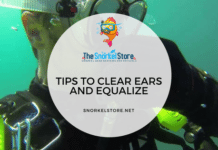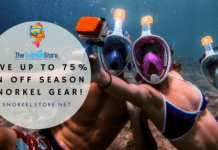Last Updated on June 21, 2023 by Snorkel Ken

What’s your first time snorkeling gong to be like? Is it going to be one of those romantic, super-exciting, picture taking awesome times? Or, is it going to be dangerous, awkward, totally not fun and (uh oh) boring?
[amazon_link asins=’B01ABTCRHI,B0777324WG,B072KJDPZX’ template=’ProductGrid’ store=’snorkelstore03-20′ marketplace=’US’ link_id=’d13f7877-d195-11e8-bfe0-e768fe74e7c2′]
The Bad News
First time snorkeling experiences are not uncommon. You can read any article you want, look at all of the beautiful pictures or turtles and fish (and people with turtles and fish!) and/or listen to all of those snorkel tour companies that makes it seem as it’s impossible to have a miserable time snorkeling and that it’s the easiest thing in the world to do.
Some of that is mostly true: It is fun and mostly easy. However, without having some sense, some basic equipment, or if you under-estimate the ocean you can put yourself in a dangerous situation. Like everything else: As long as you keep an open mind, pay attention, and grab some quality gear…you’re going to have the best time possible. (Which is, more often than not, pretty great!)
First Time Snorkeling Issues:
Any of the following can arise at any time and you need to be able to deal with it-
- Flooding mask and/or snorkel
- Fear and panic
- Exhaustion
- Cramping
- Boredom or Complacency
- Injury
The Good News:
We can help you avoid most of the issues and situations above. These are common mistakes and happenings, and with a little forethought and preparation, you can make it seem like a little thing. Let’s get to it.
The following is our best tips to new snorkelers to:
- Maximize their time in the water
- Snorkeling
- Taking pics
- Exploring and watching marine life
- Having a great time
- Staying safe.
Our Number 1 Snorkeling Tip: Don’t Rent Bad, Cheap Snorkeling Gear
Don’t even borrow bad equipment. It’s not worth the risk and the headaches. If you have to rent then don’t opt for the cheapest option. We always recommend buying your own gear and keeping for those times when you will need it. You may not snorkel all the time but with some care, your gear will last years.
If the tour that you’re renting or borrowing gear from isn’t giving you some fitting lessons along with you giving your money, then it is a bad service. No question about it.
Here are some things you need to know:
Learn How to Fit a Snorkel Mask
-There are sooo many masks and depending on size, materials, and style…each one will fit differently. Like we mentioned above, many tours and rentals will be in a hurry to get you equipped and get out in the water or out of the store. Read our Guide
-Also, you’ll find that a foggy mask can put a real blur into your fun (ha!). Make sure you have some good defogger and reapply whenever necessary. Read this.
Pick the Right Fitting Fins
-Fins also come in different sizes and styles. There are open heel fins with straps, closed heel fins, trek/travel fins, long fins, standard fins and then there are these new ones from Wildhorn Outfitters. Eesh… Which ones to get? They shouldn’t be too tight or too loose. They most definitely shouldn’t hurt to be worn.
-Hot spots will cause rubs and raw skin which will ruin your snorkeling experience and (perhaps) the next couple of days with blisters and open, raw skin.
-Never opt to NOT have fins. They’re essential for safety and to keep you stable and moving in the water. One of the most dangerous open water situations is exhaustion. Fins help save vital energy and could save a life. (Read this)
Opt for a Dry Snorkel
-You know what really sucks about snorkeling? When you get a mouth of salt water and start choking. That’s why you should always get a dry snorkel when you can, and at least a snorkel with a splash guard.
-Dry snorkels will also have a purge valve. These specially designed valves allow you to expel a quick blow of air out your mouth and push any water that may have gotten in the tube OUT of the tube quickly. This is safe and also keeps you from having to stop snorkeling whenever water gets in. Read this.
A thing About Full Face Snorkel Masks
-They may have gotten a bad rap lately, but full-face snorkel masks are pretty great WHEN THEY ARE USED FOR THEIR INTENDED PURPOSE WHICH IS LEISURELY SNORKELING AT THE SERVICE OF THE WATER. (Read this and Read this.)
-If you have facial hair or have had trouble snorkeling in the past due to fear or apprehension then full-face masks have given thousands the opportunity to actually love snorkeling. They allow people to breathe normally underwater and allow a seal even with a mustache.
-Again, don’t use full-face snorkel masks to free dive or even go deeper than 4 feet down. They’re not intended for it and they’re large build will actually make it more difficult.
Our Number 2 Snorkeling Tip: Practice and Become Familiar
How do you get better at something? How do you face your anxiety over issues because you’re unfamiliar with something? That’s right: Practice. Practice. Practice.
We usually don’t recommend going on a boat snorkel tour as the first time you go snorkeling. It doesn’t allow a lot of opportunities to practice with the gear.
Get Your Gear Early
You can get your mask early (even before you’re on vacation) and practice using it waaaaaaaaaaaay before you get to a snorkeling spot.
Practice putting on the mask and the way it feels and how the straps feel and where you put them. You should be able to slight inhale in your mask and feel it suction to your face. Read this.
Get used to the way the snorkel feels in your mouth. Is it comfortable? Don’t chew on it like gum but it should move and feel okay. I hate having my jaw get tired in the water and it usually happens when I’m using a snorkel that doesn’t feel right. (This is where the proper use of a full-face snorkel mask is pretty great.)
Whenever possible you should opt to practice snorkeling, putting on your gear, adjusting your gear, etc inside of a pool, or in calm, shallow spot on a beach. Again, we recommend that you NEVER enter the water from a boat with your first snorkeling experience without a really good dry instructional from trained professionals. And even then, you should be well monitored.
However, being in a pool or shallows will let you know if your mask leaks, can you adjust your fins underwater, etc. It takes time to get used to all of this and train your body to be independent from the land. Take your time and just enjoy the experience.
Also, if you lack some basic swimming skills (if you suck at swimming or are not confident) then use a floating apparatus like a snorkeling best or a noodle. Read this. Once you’re in the water then start getting comfortable kicking and “fluttering” which is a method of using your big thigh muscles to move your leg as a rigid unit.
When all else fails…Stay Calm. Control Any Panic. Gather your wits and then fight for your life.
Our Number 4 Snorkeling Tip: Know Your Physical Limits, Learn Basic Skills, and Be Aware of the Dangers.
Speaking of staying calm, it’s important you stay loose and open-minded.
If you actually stay relaxed and loose while in the water, you’ll use less energy and be more efficient. If you become tense and start flail, you’re going to exhaust yourself and become unable to swim. That leads to drowning. Don’t want to scare anyone, but it’s true. Stay calm, stay alive.
Your fins are very efficient for kicking and thrusting, the problem is that the snorkel will always limit your air intake, making you out of breath quicker. If you can learn to float and rest, that’s great. Just don’t fight currents and panic with more energy.
Stay Alert, Stay Alive
You need to take notice of the current ocean conditions. One thing I always did in Hawaii was to take not of what the Islanders were doing. If the native Hawaiians weren’t messing with the ocean that day, then I definitely wasn’t. That’s a pretty good cue in all situations.
If you’re unaware of who the natives are, don’t be afraid to ask.
Getting an understanding of currents, surges, waves, rip ties, noticing and adhering to warning signs is a huge thing. Just knowing how your body will move with the moving ocean goes a long, long way.
Our Number 3 Snorkeling Tips for Beginners: Choose Your Spot with Care and Thought
Whether you’re part of a boat tour, listening to advice, or just researching choosing spots online, do a little research, think deeply about the conditions and remember that just because people say it’s a great spot to snorkel doesn’t mean it’s a great spot to snorkel on that day.
A perfect example of this is Shark’s Cove on Oahu. During the summer months it’s like a pond; calm, clear and awesome for snorkeling and diving. During the winter months, it’s calamity and commotion. Dangerous. Know these things. BLUF: If it looks rough then it’s rough.
For first time snorkelers, we definitely recommend going from the shore, a calm beach, for instance. It can be a little nerve racking to jump off a boat into deep water during your first experience…you just don’t know how you’re gonna react.
Lastly. on this subject of choosing a snorkeling spot, we’ll say this: Sandy beaches with no rock and coral are usually bad for snorkeling. The water is too cloudy and there’s no marine life. Fish, plants, turtles, etc…they all need and live among rocks and reef. One of my favorite places to snorkel on Oahu is along a small tide-wall at Pililau Army Rec Center; logs to fish, turtles, and shells.
Our Number 5 Snorkeling Tip: Come at the Activity of Snorkeling with an Open Mind
We all snorkel for different reasons. For me, it was the opportunity to see marine life and take images for this site and our Facebook page. To make memories.
Snorkeling is a lot about what you want to get out of it. Some of my best time snorkeling was in 100 feet of water with a pod of dolphins at Honaunau on the Big Island, Hawaii.
But you know what? I also like swimming among coral and rocks in like 4 or 5 feet of water and just floating and bobbing with the tide and just observing: I feel like I’m in a meditative state some of the time. Snorkeling is one of the most relaxing and or exciting experiences in life.
Our Last New Snorkelers Tip: Be Respectful
This is going to be offensive to some people. Please don’t it personally: DON’T BE AN ASSHOLE. It’s really as simple as that.
Take care of and have respect for the ocean. Don’t walk on the reef or break pieces off for “keepsakes”. Don’t touch or harass marine life. (For your safety as well as theirs.) We have a whole page on snorkeling etiquette that you can read here.
Pay attention to the type of sunscreen you use; there are coral friendly brands and brands that can kill coral.
Don’t feed the fish. It may attract them but all it does is disrupt the natural order of things.
[amazon_link asins=’B01ABTCRHI,B00L9IKH28,B075DHNSJ4′ template=’ProductGrid’ store=’snorkelstore03-20′ marketplace=’US’ link_id=’6ed475f6-d195-11e8-ac58-2b23af500f51′]









